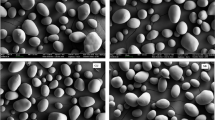Abstract
The major tuber sugars—glucose, fructose and sucrose — in tubers of the Red Pontiac, Kennebec and Monona potato varieties harvested five times during the 1970 growing season were determined quantitatively by a gas-liquid Chromatographic technique. Also, chips were made from tubers and chip color was measured objectively and reported as Rd values. Red Pontiac tubers produced the darkest-colored chips (Rd-15.5), and its tubers tended to accumulate the highest levels of the three sugars. The major difference between Monona, which produced chips with the lightest color (Rd-21.1), and Kennebec (Rd-19.5) was the very low level of glucose found in the tubers of Monona.
Varieties produced chips lightest in color at the second (8/31) or third (9/15) harvest dates. Conversely, darkest-colored chips were obtained from each variety at the fourth harvest date (9/28). This was attributed to the cool, wet weather. Sugar content also varied during the harvesting schedule. Glucose content changed little until late in the season when an increase occurred. Fructose tended to decline until the final harvest when a distinct increase was obtained. Sucrose declined significantly through the third harvest, but changed little thereafter.
Resumen
Se determinó el contenido de glucosa, fructosa, y sacarosa en tubérculos de papa de los cultivares Red Pontiac, Kennebec, y Monona, provenientes de 5 épocas de cosecha en 1970. El contenido de azúcar fué medido por cromatografía de gas y líquido y el calor de los chips por Rd (reflectancia). Los tubérculos de Red Pontiac produjeron los chips más oscuros (Rd-15.5) y fueron los de mayor contenido de azúcar. Monona produjo chips más claros (Rd-21.1) que Kennebec (Rd-19.5) y tuvieron menos glucosa.
El color de los chips se hizo más claro hasta la tercera cosecha y luego declinaron severamente en las 2 últimas cosechas, debido probablemente al clima frío y húmedo. El contenido de azúcar también varió durante la estación. La glucosa fue estable hasta el fin de la estación. La fructosa declinó hasta la cosecha final donde se incrementó muy claramente. La sacarosa declinó significativamente hasta la tercera cosecha, pero no cambió en adelante.
Similar content being viewed by others
Literature Cited
Appleman, C. O. and E.V. Miller. 1926. A chemical and physiological study of maturity in potatoes. J Agric Res 33: 569–577.
Habib, A. T. and H. D. Brown. 1956. Factors influencing the color of potato chips. Food Technol 10: 332–336.
Habib, A. T. and H. D. Brown. 1957. Role of reducing sugars and amino acids in the browning of potato chips. Food Technol 11: 85–89.
Lee, C. Y., R. S. Shallenberger and M. T. Vittum. 1970. Free sugars in fruits and vegetables. New York State Agric Expt Stn Food Sci and Technol Bull 1.
Murphy, H. J. and M. J. Goven. 1967. Factors affecting chip color of the white potato in Maine. Maine Agric Expt Stn Bull 651.
Patton, A. R. and W. E. Pyke. 1946. The role of amino acids and glucose in the browning of potato chips and dehydrated potatoes. (Abstr.) 110th Meeting, A.C.S., div. Agric Food Chem.
Pressey, R. 1969. Potato sucrose synthetase: purification, properties, and changes in activity associated with maturation. Plant Physiol 44: 759–764.
Samotus, B.. and S. Schwimmer. 1962. Predominance of fructose accumulation in coldstored immature potato tubers. J Food Sci 27: 1–4.
Schwimmer, S., A. Bevenue, W. J. Weston and A. L. Potter. 1954. Survey of major and minor sugar and starch components of the white potato. J Agric Food Chem 2: 1284–1290.
Shallenberger, R. S., O. Smith and R. H. Treadway. 1959. Role of the sugars in the browning reaction in potato chips. J Agric Food Chem 7: 274–277.
Singh, B. N. and P. B. Mathur. 1937. Studies in potato storage: I. Investigations of physiological and chemical changes during the development and ripening of potato tubers. Ann Appl Biol 24: 469–474.
Singh, B. N. and P. B. Mathur. 1938. Studies in potato storage: II. Influence of (1) the stage of maturity of the tubers and (2) the storage temperature for a brief duration immediately after digging, on physiological losses in weight of potatoes during storage. Ann Appl Biol 25: 68–78.
Sweeley, C. C., R. Bentley, M. Makita and W. W. Wells. 1963. Gas-liquid chromatography of trimethylsilyl derivatives of sugars and related substances. J Am Chem Soc 85: 2497–2507.
Talburt, W. F. and O. Smith. 1967. Potato chips.In Potato Processing. 2nd ed. pp. 262–339. The Avi Publishing Co., Inc. Westport, Conn.
Walkof, C. 1970. Chip color of the developing potato tuber. Am Potato J 47: 43–48.
Author information
Authors and Affiliations
Additional information
Authorized for publication on July 5, 1972 as paper No. 4257 in the Journal Series of the Pennsylvania Agricultural Experiment Station.
Rights and permissions
About this article
Cite this article
Miller, R.A., Harrington, J.D. & Kuhn, G.D. Effect of variety and harvest date on tuber sugars and chip color. American Potato Journal 52, 379–386 (1975). https://doi.org/10.1007/BF02852792
Received:
Issue Date:
DOI: https://doi.org/10.1007/BF02852792




